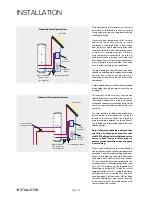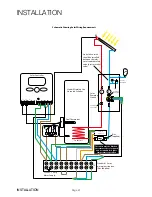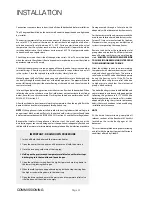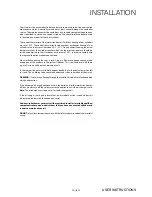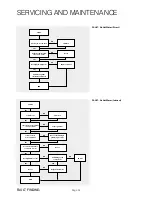
Page 12
General Design Considerations
The cupboard footprint needs to be at least 650mm square for standard units up to
300 litres, 730mm for 400 litre and 575mm for slimline units. The base chosen for the
cylinder should be level and capable of supporting the weight of the unit when full of
water as shown in General Data. The discharge pipework for the safety valves must have
a minimum fall of 1 : 200 from the unit to a safe discharge point. All exposed pipework
and fittings on the cylinder should be insulated, and the unit should NOT be fixed in a
location where the contents could freeze.
In new systems, pipes should be insulated to comply with building regs, the maximum
permissible heat loss is indicated in the table opposite, and labelled accordingly as follows:
i. Primary circulation pipes for domestic hot water circuits should be insulated
through their length, subject only to practical constraints imposed by the need
to penetrate joists and other structural elements.
ii. All pipes connected to hot water storage vessels, including the vent pipe, should
be insulated for at least 1 metre from their points of connection to the cylinder (or
they should be insulated up to the point where they become concealed).
In replacement systems, whenever a boiler or hot water storage vessel is replaced in
an existing system, any pipes that are exposed as part of the work or are otherwise
accessible should be insulated as recommended for new systems, or to some lesser
standard where practical constraints dictate.
The pipe connecting the boiler flow to the appliance must not be less than 22mm
copper or equivalent.
Standard and Slimline Model Selection Guide
Max hot water demand
Max number
of bed spaces
(Bedrooms)
Indirect
litres
Direct
litres
1 shower room
Bedsit (0)
90
120
1 bathroom
2 (2)
120
150
1 bathroom
4 (3)
120
180
1 ba separate shower room
6 (4)
150
210
1 ba 2 separate shower rooms
or 2 bathrooms
7 (5)
180
210
2 bat separate shower room
7 (5)
210
250
2 bat 2 separate shower rooms
7 (5)
250
300
3 bat 2 separate showers rooms
9 (6)
300
400
3 bat 3 separate showers rooms
9 (6)
400
-
Solar Model Selection Guide
Max hot water demand
Bedrooms
Indirect
litres
Direct
litres
1 shower room
Bedsit
-
180
1 bathroom
1-3
180
-
1 bathroom
1-3
210
1 ba 1 shower room
1-3
210
-
1 ba 1 shower room
1-3
-
250
1 ba 2 shower rooms
2-4
250
-
1 ba 2 shower rooms
2-4
-
300
2 bat 1 shower room
3-4
300
-
2 bat 1 shower room
4-5
-
400
2 bat 2 shower rooms
4-5
400
-
INSTALLATION
INSTALLATION
Further guidance on converting heat loss limits
to insulation thickness for specific thermal
conductivities is available in TIMSA “HVAC
guidance for achieving compliance with Part L
of the Building Regulations”.
Mains Water Supply
Existing properties with a 15mm supply will be
satisfactory provided the local mains pressure is
good, but should be confined to single bathroom
properties. For new properties where simultaneous
demand is required to more than one bathroom
or a bathroom and one or more en-suites, the
communication and service pipe into the dwelling
should be a minimum of 22mm (usually in the
form of a 25mm MDPE supply). The optimum
performance is achieved if the inlet pressure is 3 bar
dynamic. However, the Stainless Lite will function
with lower inlet pressures, but this will reduce the
performance. For optimum performance, 30L per
minute incoming mains flow should be present,
however the Stainless Lite will work at lower flow
rates, although performance will be affected.
Normally Stainless Lite provides well in excess of
40 litres/min in most conditions. Flow rates for
ALL mains pressure systems are subject to district
pressures and system dynamic loss. Particularly on
larger properties with more than one bathroom,
the pipe sizes should be calculated in accordance
with BS EN 806-3:2006 and BS 8558:2011.
Model Selection
The suggested Direct model sizes, shown
opposite, are based on a typical days hot water
use assuming an Economy 7 tariff is provided.
A reduction of one model size can normally
be made with an Economy 10 tariff. When
using the Direct models for high specification
developments an increase of one model size
should be considered.
The suggested model sizes are based on typical hot
water usage. For high specification dwellings an
increase of one model size should be considered.
Insulation of pipework
Pipe outside
diameter
Maximum
heat loss
15mm
7.89W/m
22mm
9.12W/m
28mm
10.07W/m
35mm
11.08W/m


















